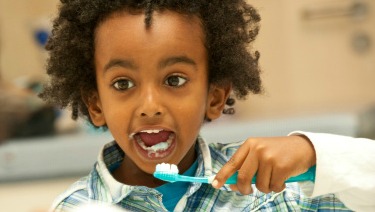Vaccine records online:
Go to:
https://myvaccinerecord.cdph.ca.gov
Click on Request Record, enter your child’s information and your information, click submit.
You will receive an email or test with a link, click on the link, your records will be available


HPV Vaccine: What Parents Need to Know
Click on the link to access information below
HPV Vaccine: What Parents Need to Know
FAQs About HPV

What is human papillomavirus (HPV)?
My 16-year-old missed the HPV vaccine. Is it too late to get it?
How common is HPV?
How will my child feel after getting the HPV vaccine?
Why do all kids need the HPV vaccine?
Why is the HPV vaccine recommended at ages 9-12?

Dental Health & Hygiene for Young Children

As you might guess, the number-one dental problem among preschoolers is tooth decay.
- One out of 10 two- year-olds already have one or more cavities
- By age three, 28% of children have one or more cavities
- By age five, nearly 50% of children have one or more cavities
Many parents assume that cavities in baby teeth don’t matter, because they’ll be lost anyway. But that’s not true. Dental decay in baby teeth can negatively affect permanent teeth and lead to future dental problems.
Teaching Good Dental Habits
The best way to protect your child’s teeth is to teach him good dental habits. With the proper coaching he’ll quickly adopt good oral hygiene as a part of his daily routine. However, while he may be an enthusiastic participant, he won’t yet have the control or concentration to brush his teeth all by himself. You’ll need to supervise and help him so that the brush removes all the plaque—the soft, sticky, bacteria- containing deposits that accumulate on the teeth, causing tooth decay. Also, keep an eye out for areas of brown or white spots which might be signs of early decay.
Toothbrushing
As soon as your child has a tooth you should be helping your child brush her teeth two times a day with a smear (size of a grain of rice) of fluoride toothpaste on a child-sized toothbrush that has soft bristles. There are brushes designed to address the different needs of children at all ages, ensuring that you can select a toothbrush that is appropriate for your child.
Amount of Toothpaste
At age 3, you can start using a pea-size amount of fluoride toothpaste, which helps prevent cavities. If your child doesn’t like the taste of the toothpaste, try another flavor. Also try to teach your child not to swallow it, although at this age they are often still too young to learn to rinse and spit. Swallowing too much fluoride toothpaste can make white or brown spots on your child’s adult teeth.
Brushing Motion
You’ll hear all kinds of advice on whether the best brushing motion is up and down, back and forth, or around in circles. The truth is that the direction really doesn’t matter. What’s important is to clean each tooth thoroughly, top and bottom, inside and out. This is where you’ll encounter resistance from your child, who probably will concentrate on only the front teeth that he can see. It may help to turn it into a game of “find the hidden teeth.” Incidentally, a child cannot brush his teeth without help until he’s older—about six to eight years old. So be sure to supervise or do the actual brushing if necessary.
Too Much Sugar
Besides regular toothbrushing with the right amount of fluoride toothpaste, your child’s diet will play a key role in his dental health. And, of course, sugar is the big villain. The longer and more frequently his teeth are exposed to sugar, the greater the risk of cavities. “Sticky sugar” foods such as sticky caramel, toffee, gum, and dried fruit—particularly when it stays in his mouth and bathes his teeth in sugar for hours—could do serious damage. Make sure to always brush your child’s teeth after a sugary food item. In addition, do not allow your child to have any sugar-containing liquid in a sippy cup for a prolonged period.
Dental Checkups
During regular well-child visits, the pediatrician will check your child’s teeth and gums to ensure their health. If she notices problems, she may refer your child to a pediatric dentist (pedodontist) or a general dentist with an interest in treating the dental needs of children. Both the American Academy of Pediatrics and the American Academy of Pediatric Dentistry recommend that all children see a pediatric dentist and establish a “dental home” by age one.
As part of her dental checkup the dentist will make sure all teeth are developing normally and that there are no dental problems and give you further advice on proper hygiene. She also may apply a topical fluoride solution to provide extra protection against cavities. If you live in an area where the water is not fluoridated, she may prescribe fluoride drops or chewable tablets for your toddler. For more guidance on fluoride supplements, talk to your pediatrician.
Additional Information:
- Toothbrushing Tips for Young Children
- FAQ: Fluoride and Children
- Why Regular Dental Visits Are Important
- How to Prevent Tooth Decay in Your Baby
https://healthychildren.org/English/tips-tools/ask-the-pediatrician/Pages/Will-it-be-safe-for-our-family-to-travel-over-spring-break.aspx
Tips on sleep
Getting Your Baby to Sleep

What’s the best way to get my child to go to sleep?
Babies
Babies do not have regular sleep cycles until about 6 months of age. While newborns sleep about 16 to 17 hours per day, they may only sleep 1 or 2 hours at a time. As babies get older, they need less sleep. However, different babies have different sleep needs. It is normal for a 6-month-old to wake up during the night but go back to sleep after a few minutes.
Here are some suggestions that may help your baby (and you) sleep better at night.
- Keep your baby calm and quiet when you feed or change her during the night. Try not to stimulate or wake her too much.
- Make daytime playtime. Talking and playing with your baby during the day will help lengthen her awake times. This will help her sleep for longer periods during the night.
- Put your baby to bed when drowsy but still awake. This will help your baby learn to fall asleep on her own in her own bed. Holding or rocking her until she is completely asleep may make it hard for her to go back to sleep if she wakes up during the night.
- Wait a few minutes before responding to your child’s fussing. See if she can fall back to sleep on her own. If she continues to cry, check on her, but don’t turn on the light, play with her, or pick her up. If she gets frantic or is unable to settle herself, consider what else might be bothering her. She may be hungry, wet or soiled, feverish, or otherwise not feeling well.
Toddlers and preschoolers
Many parents find their toddler’s bedtime to be the hardest part of the day. Children this age often resist going to sleep, especially if they have older siblings who are still awake.
Use the following tips to help your toddler develop good sleep habits:
- Set up a quiet routine before bedtime to help your child understand that it will soon be time to go to sleep. Use this time to read him a story, listen to quiet music, or give him a bath. It may be tempting to play with your child before bed. However, active play may make your child too excited to sleep.
- Be consistent. Make bedtime the same time every night. This helps your child know what to expect and helps him establish healthy sleep patterns.
- Allow your child to take a favorite thing to bed each night. It’s OK to let your child sleep with a teddy bear, special blanket, or some other favorite toy. These often help children fall asleep—especially if they wake up during the night. Make sure the object is safe. Look for ribbons, buttons, or other parts that may be choking hazards. Stuffing or pellets inside stuffed toys can also be dangerous.
- Make sure your child is comfortable. He may like to have a drink of water, a light left on, or the door left slightly open. Try to handle your child’s needs before bedtime so that he doesn’t use them to avoid going to sleep.
- Do not let your child sleep in the same bed with you. This can make it harder for him to fall asleep when he is alone.
- Do not return to your child’s room every time he complains or calls out. Instead, try the following:
- Wait several seconds before answering and make your response time longer each time he calls. This will give him a chance to fall asleep on his own.
- Reassure your child that you are there. If you need to go into the room, do not turn on the light, play with him, or stay too long.
- Move farther from your child’s bed every time you go in, until you can reassure him verbally without entering his room.
- Remind him each time he calls that it’s time to go to sleep.
- Give it time. Helping your child develop good sleep habits can be a challenge, and it is normal to get upset when a child keeps you awake at night. Try to be understanding. A negative response by a parent can sometimes make a sleep problem worse.
Talk to your primary care physician if you need further advice during your next physical examination
https://www.healthychildren.org/English/ages-stages/baby/sleep/Pages/getting-your-baby-to-sleep.aspx